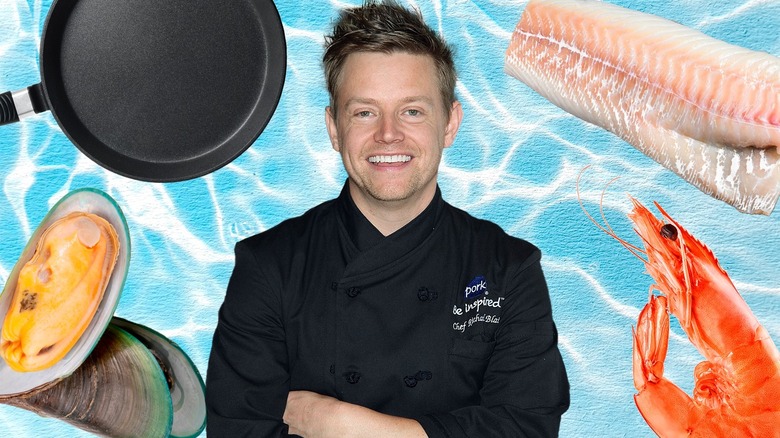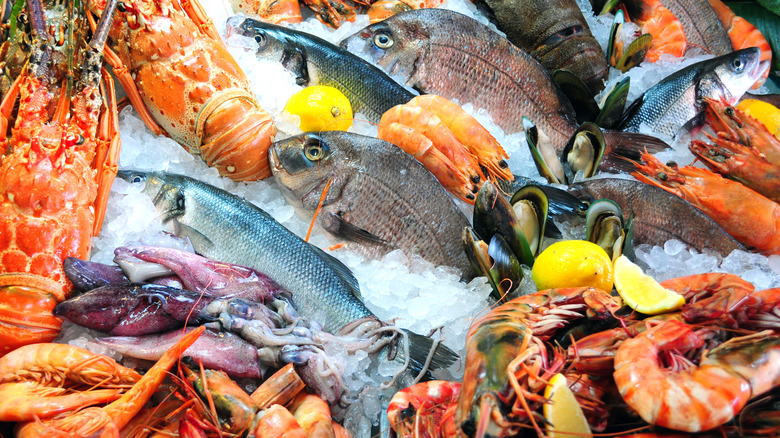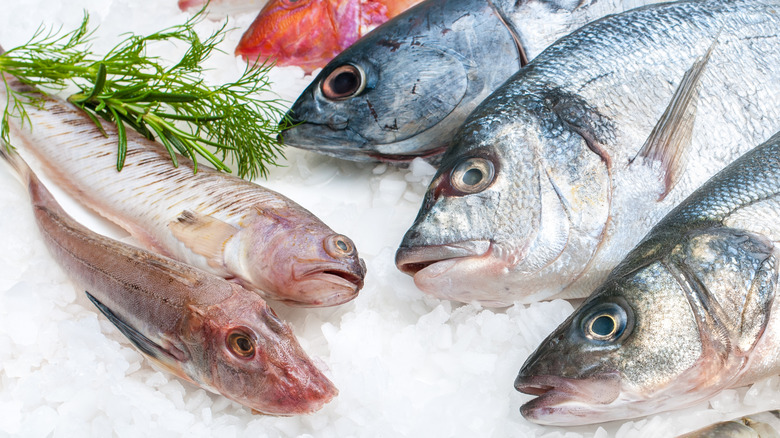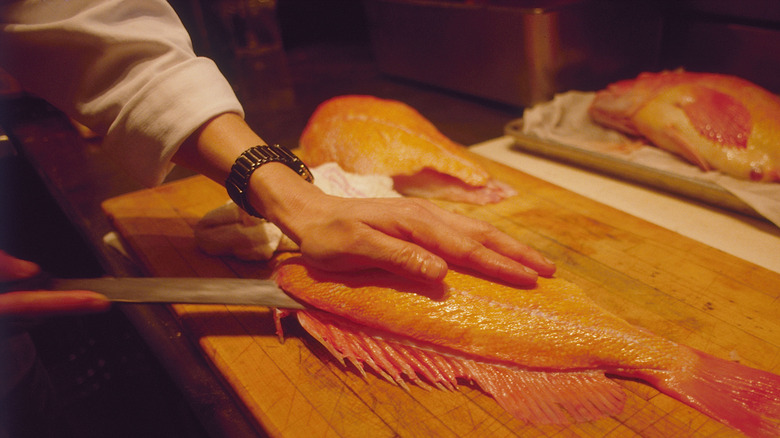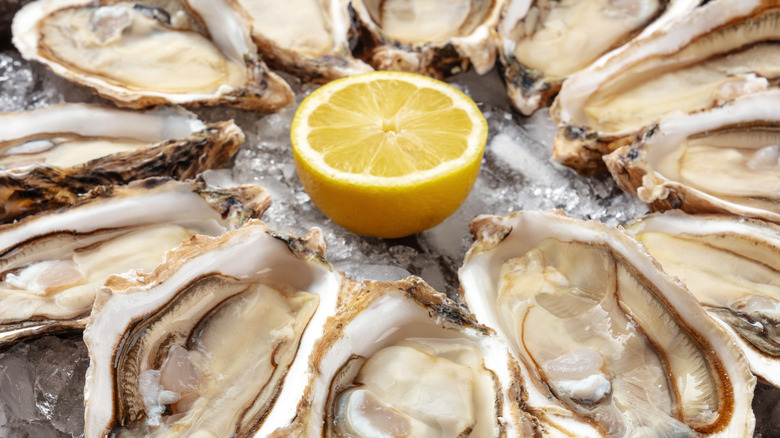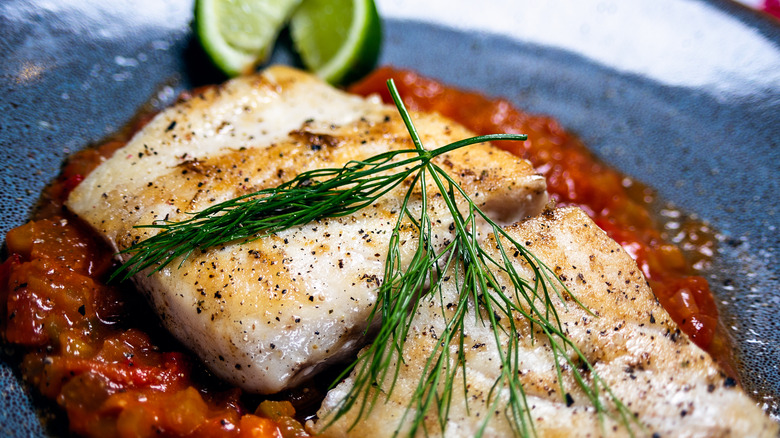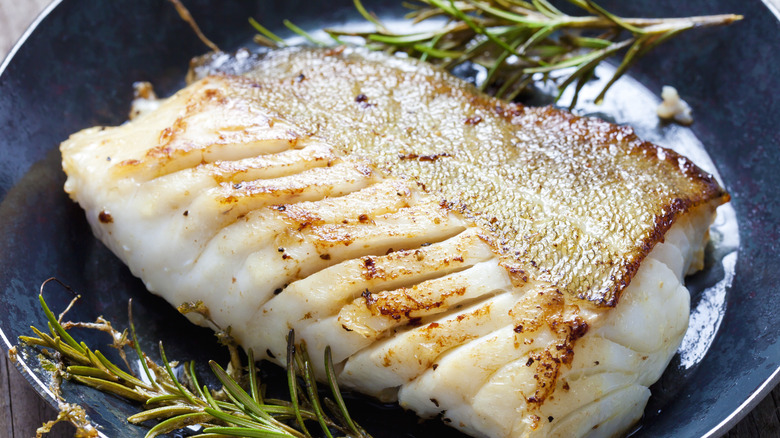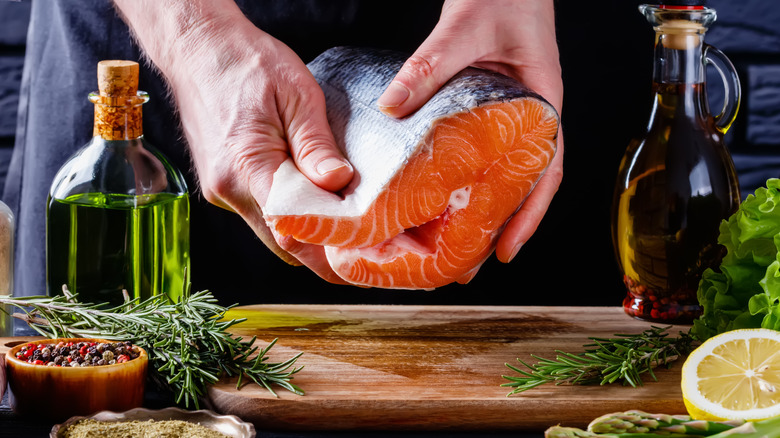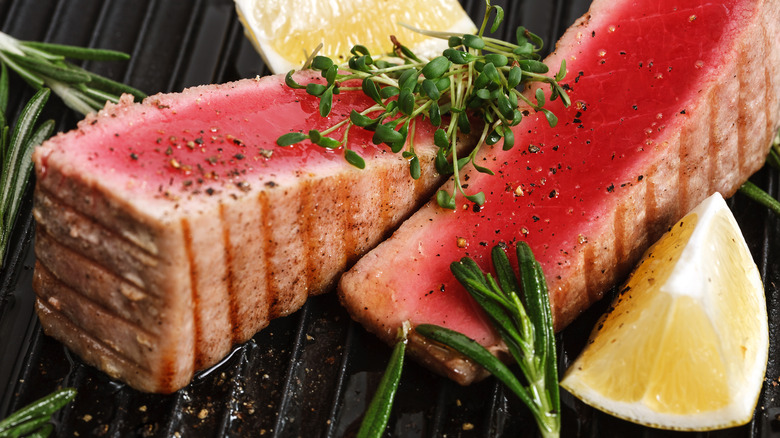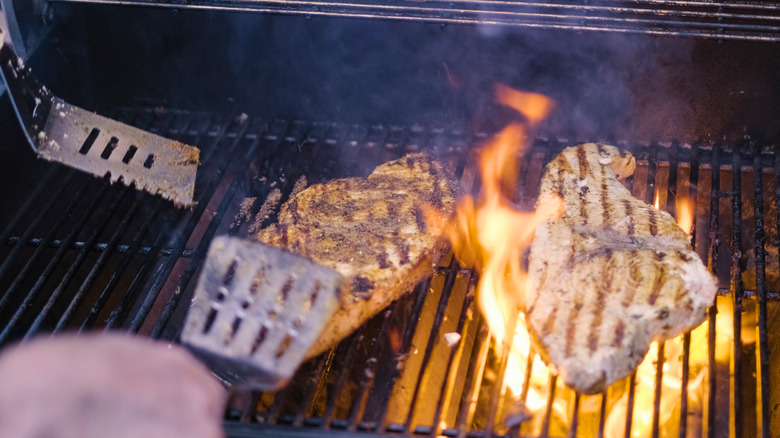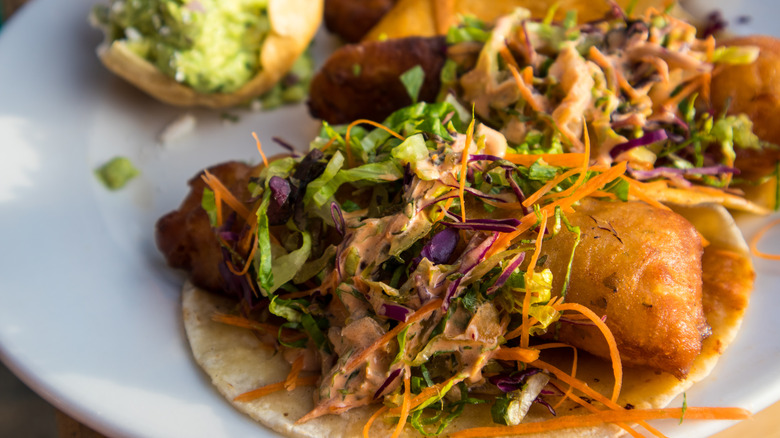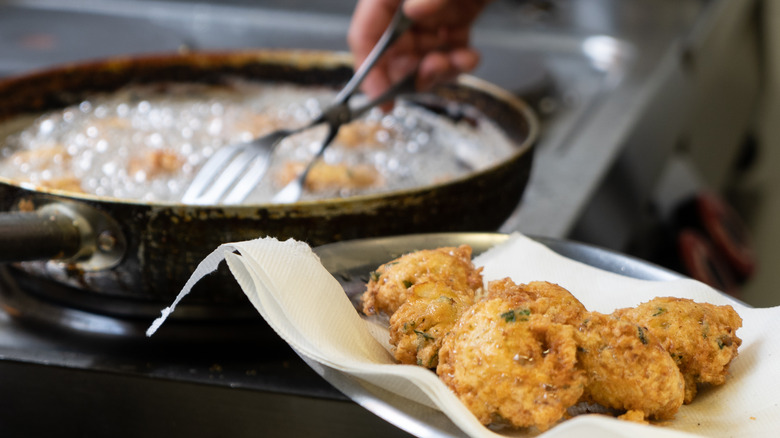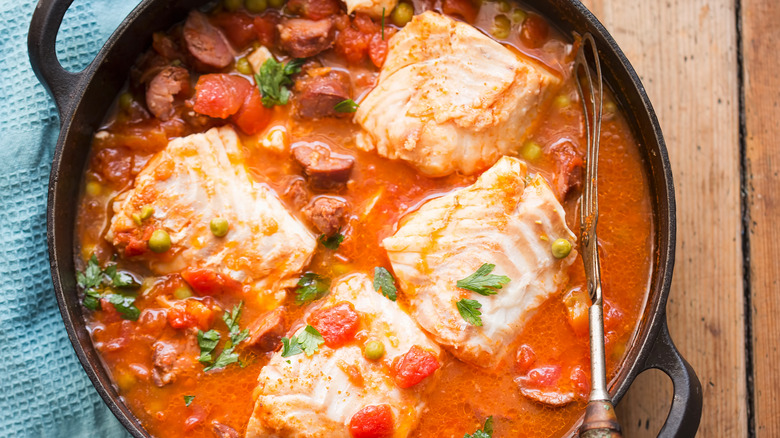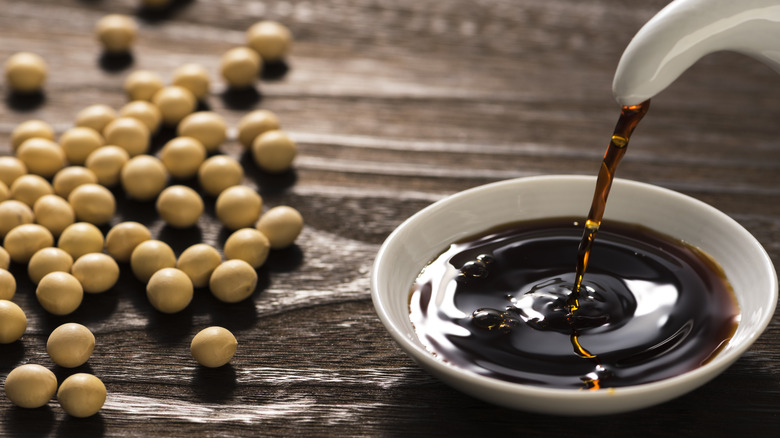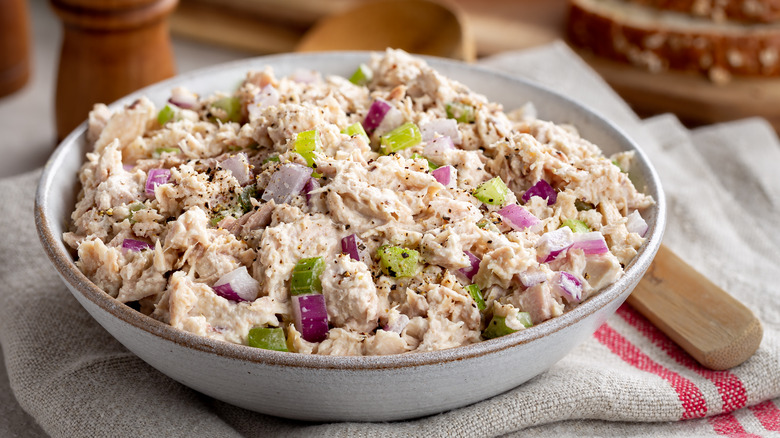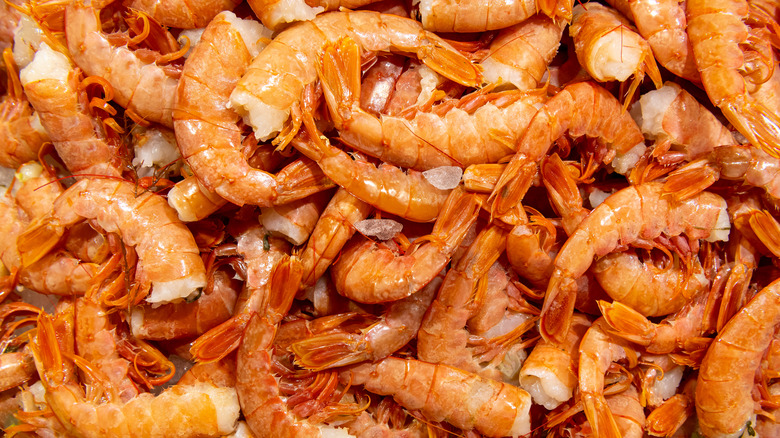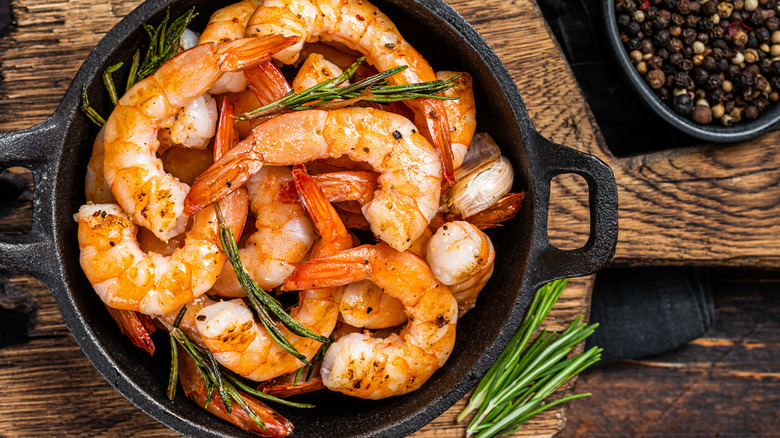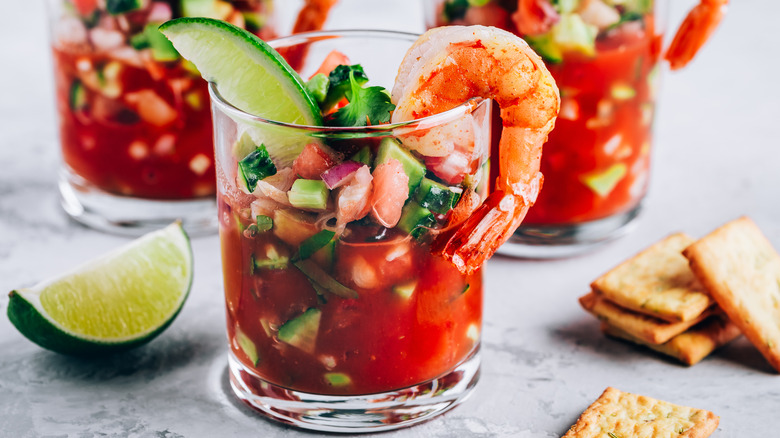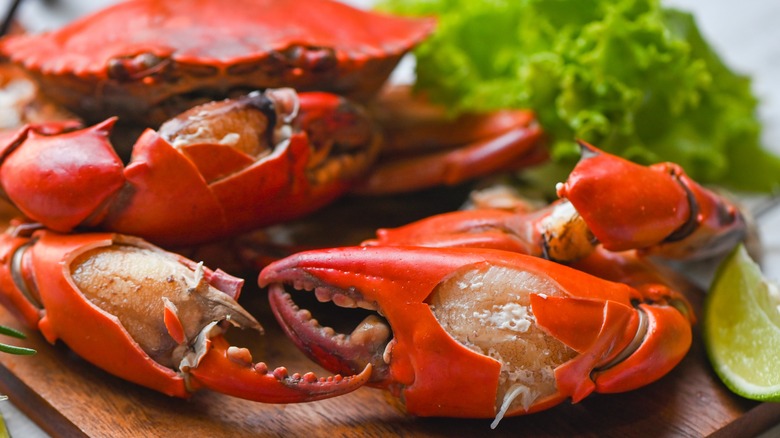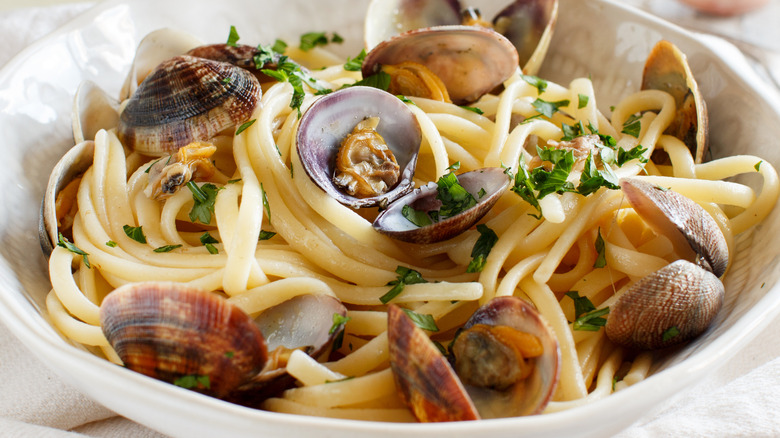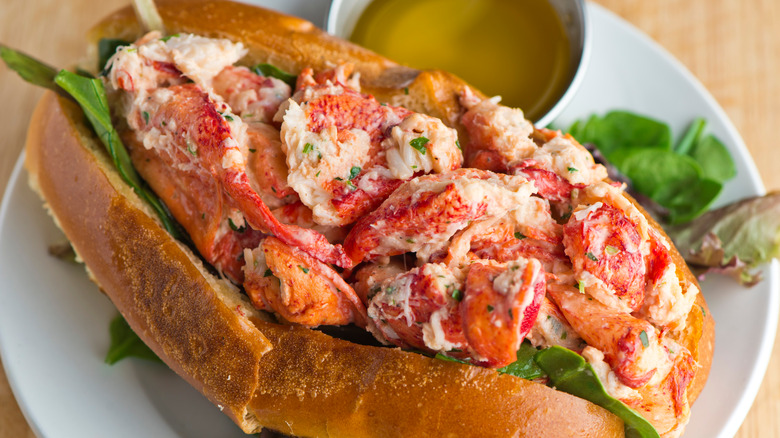The 20 Best Seafood Tips And Tricks From Richard Blais - Exclusive
"Top Chef" champ and "Next Level Chef" host Richard Blais wants you to think about his brand new Key West Four Flamingos as the blockbuster prequel to the eatery's Orlando-based predecessor. "Almost as if it's a Marvel movie," he tells Tasting Table in an exclusive interview, "this is 'How Wolverine Got His Claws.'" The restaurant tells the region's history — from Hemingway to the treasure-hunting Mel Fisher — through food with local standards given the signature whimsical Blais spin. Take the crab salad-stuffed avocado rolled in black, dehydrated lime. "It looks ... literally like you just grabbed an avocado from the market and just put it on a plate," says Blais. "To me, that's when food is great ... there's a story, it's delicious, and it's surprising."
Crab is far from the only seafood offering on the Flour Flamingos Key West menu. As a dockside restaurant, Blais reveals, "We're going to have fisherman come to the restaurant and say, 'hey, this is what I've got in the boat today.'" Blais, of course, is no stranger to coastal cooking, having opened several restaurants across San Diego. Below, the superstar chef shares with us some of his best seafood tricks and tips, diving into everything from tuna salad and shrimp cocktail to fish preparation and inspection.
1. A fresh catch shouldn't smell 'fishy'
Welcome to Richard Blais teaches you Seafood Inspection 101. First lesson: Bad seafood smells are straight-out-of-a-horror-movie alarming, so before you make your purchase, give it a sniff. Take shellfish, for example. "A truly bad one will let you know right away," Blais assures us. So, if you're nose detects something is off, trust your instinct and pass on that purchase.
The aroma of quality fish, on the other hand, is less straightforward. To identify the good stuff, Blais notes that you may need to unlearn something you've taken for granted — the idea that "seafood [should] smell fishy." In fact, that's a red flag. A fresh fish, according to the celebrity chef, will smell like "the sea, like salt water, and cucumber."
2. Look for clear eyes
Aromas aside, there are other factors to keep in mind when buying whole fish. Touch a fish's skin, and it should feel slick, Blais tells us. Look at its body, and it should shine. Dehydration, however, is a sign that a fish is past its prime and you should go with another option. In order to determine if that's the case, a stare-down is in order.
Before purchasing your fish, always check the condition of the eyes. "You want to make sure that they're clear," Blais advises. "Whether it's the eyes or the flesh itself — it shouldn't look dry. Just think about really anything, any protein or vegetable that really sits out exposed to the air, it's going to dry up, right?"
3. Leave the knife work to the professionals
Blais knows a thing or two about how to properly butcher a fish — he spent a year as a Fellowship Instructor at the Culinary Institute of America doing just that. If that doesn't happen to be on your resume, you may want to opt out of that particular adventure. "I will say for the home cook, the best option is to have someone cut it for you, it's probably going to be more convenient [and] and it's going to be less messy," says Blais. "Even in my own restaurants, [I] let the experts do the expert things."
Buying a fresh, whole fish allows for a full-body inspection, and is one way to ensure optimal straight-off-the-boat seafood freshness. So before you let a pro cut into the catch, make sure to examine it first.
4. If an oyster is dry on the inside, don't eat it
Blais could write a love poem to the algae-eating bivalves of the sea, especially fresh. "You don't have to do much to [a fresh oyster], [you taste the] seawater, and the salt — you know where the oyster was harvested, that's just fantastic," the chef gushed.
Of course, even when served on a silver platter, delighting in uncooked oysters and other shellfish is risky. To diminish risk, steer clear of open shells. "That means that the oyster itself is dead," according to Blais. After you've opened the shell yourself, check for moistness. If the "the flesh of the meat" inside your shellfish is dry — be it an oyster, a clam, or a mussel — "that's no good," Blais warns.
5. Mahi mahi is an excellent gateway into the seafood world
If you've got a case of seafood cooking phobia, it's probably best to avoid lobster bake or another extravagant undertaking. Consider, instead, mahi mahi, which can withstand a variety of cooking methods and seasonings. "I hate to say 'it's a good fish for people who haven't had seafood in a while,' but I think the fact that it's got this firm texture, but that it also retains a lot of natural moisture makes it a great fish for something like tacos, or something you could flake," Blais tells us. "To me, that's probably one of the reasons why it's so magical."
Shrimp is also a beginner-friendly quick cook, per Blais. For a beyond-simple preparation, he recommends cooking the crustaceans in a sauté pan with garlic and butter for 90 seconds per side, and Bob's your uncle.
6. Cranking up the heat will help prevent your fish from sticking
Few mishaps are more frustrating when cooking fish than having your filet stick to the cooking surface and fall apart. The likely culprit. according to Blais, is not enough heat. "This is why people don't cook fish at home," he says. "They had the first experience where their pan doesn't get hot enough and then the fish sticks to the grill or sticks to the pan and then they can't get it off."
To avoid that apocalyptic scenario of having your precious catch fall apart, get your pan or grill piping hot before turning the heat down again. "You should see a little bit of smoke in the oil or clarified butter," Blais advises.
7. Use a knife to scrape off excess moisture
Think of salmon as an unfortunately typecast Hollywood actor. "We just look at it like, 'Oh, it's a super healthy food source,' but it's one of my favorite fish to cook," Blais tells us. "You can visually see the temperature in it — you can see it go from rare to well done — and it's quite delicious in all of those moments of cooking as well." At home, he cooks salmon in cast iron with clarified butter on medium heat, skin-side down. After flipping it, he adds herbs, more butter, and lemon.
But before he gets cooking, Blais implements a two-part drying method on your salmon to make it pan-ready. First, he pats it down with a paper towel. Then, the chef uses the back of his knife to remove any additional moisture. "Whether it's meat or fish a dry surface into a hot pan it's going to get a better sear or a better crust on it," he says.
8. Mahi mahi, tuna, and swordfish are top contenders for the grill
It's summertime, living is easy, fish are jumpin', but hot kitchens are fire and brimstone. If you're taking your seafood cooking outdoors, Blais recommends prioritizing mahi mahi, tuna, and swordfish. That's because these sturdy fish "can stand up to the grill so you can get that summertime, sort-of charred flavor."
What's more, all three fish will put up with any spices you want, and it's well worth experimenting. Blais recalls his early days working in classic French kitchens and eschewing complex spice blends for a simple salt and pepper season. "That's not true anymore," he notes. Go ahead and try a Cajun blackening spice or a Moroccan seafood seasoning for an added burst of flavor. The world (forgive the seafood analogy) is your oyster.
9. It's actually okay to 'undercook' swordfish
Don't shoot the messenger — if your swordfish attempts have thus far disappointed, it's probably your fault. "[People] blame the swordfish for being dry," Blais says. "It's the magician, not the wand." At both of his Four Flamingos locations, Blais prepares a swordfish "prime rib" on the bone, which helps the steak — per the "Next Level Chef" host — "retain moisture."
Beyond keeping the bone intact, he offers another recommendation to prevent a dry interior: Don't be afraid to undercook swordfish. "People think because it's a white-flesh fish that it has to be cooked all the way through, but that's not the case," he tells us. Per Blais, you should cook swordfish just a little longer than you would ahi tuna. His sweet spot is medium-rare to medium, adding that a little bit of "translucency" in the middle of the fish is no problem.
10. Choose cod for fried fish tacos
No seafood tip list would be complete without taking on fish tacos and Blais offers multiple paths. Mahi mahi is great for grilled varieties. Looking for a Japanese take on a Mexican classic? Simply go sashimi-style. "If we want to get real Wolfgang Puck, let's just do some ahi tuna raw on a taco," he suggests. "Let's do it, like, he's a legend, let's let it rip."
But if fried fish is the object of your Taco Tuesday daydreams, not any variety will do and Blais has a top pick in mind. He recommends opting for anything in the cod family, which includes haddock, pollock, and hake. According to Blais, these firm, flavorful, and relatively inexpensive white fish options are "fantastic fish to fry."
11. Adding rice flour will make your fried fish extra crispy
You can make your fried fish pub-worthy by preparing a batter aerated with beer, a combination of beer and vodka, or soda water. But Blais recommends another addition to help take your recipe to the next level: rice flour. According to the celebrated chef, rice flour makes for crispier results. "What we're just trying to do [with the flour] is dry the fish off a little bit, so that the batter sticks to it, " Blais explains. "[Rice flour is] a little bit lighter for me."
Blais recommends quickly coating your fish in rice flour. Then pat it off to ensure a light dusting. Finally, dip your fish in a very bubbly batter to ensure a shatteringly crunchy exterior.
12. Sauce can save overcooked fish
If you end up overcooking your precious fish filet or steak, keep calm and carry on with some liquid rejuvenation. "Sauce is your friend," Blais advises. "That's where you can get out of some trouble ... don't be afraid to let things hang out in some sauce, a butter jacuzzi, I like to call it." Blais suggests an "herbaceous" sauce for summer months, be it chimichurri, salsa verde, or anything pesto-adjacent. He is also a self-proclaimed admirer of putting fish together with salsa. Referring to that popular '90s pairing, he admits, "I think sometimes modern chefs ... we get mad at things that become ubiquitous because we maybe didn't create them or because everyone does them we get offended by them."
For those of you with no objection going old school, mango salsa, in particular, is a perfect complement to summertime fish. To prepare the condiment à la Blais, combine ripe mango with red onion, cilantro, vinegar, and a little white soy sauce. Here's a pro tip from a culinary master: Use the cilantro leaves and stems in your recipes. Stems, says Balis, "actually have a little bit more flavor."
13. Use soy to enhance your seafood sauces
For this next tip, simply open your fridge. Soy sauce, Blais reveals, is a secret weapon in many of the chef's salsas and sauces. The popular Asian condiment provides a double hit of "umami" and "savory salt" flavor. For optimal results, he recommends using the subtle yet sweet white shoyu, particularly to enhance your tuna salad.
However, if you do integrate soy sauce into your seafood sauces, don't use it at the expense of salt. "Soy, and umami and salt — they need to work together," Blais cautions. "I think that's a common mistake: 'Oh, I put parmesan in this so I don't need to add salt.'" If you include both soy and salt, the combo will provide your seafood with a full flavor explosion.
14. The key to a perfect tuna salad isn't ingredients, it's the method
There is perhaps no better way to use a can of tuna than in a salad, and Richard Blais knows this better than most. "I was the kid in second grade who had a tuna sandwich and everyone was like, 'what are you eating?,'" he confides. Thankfully, his school peers didn't put him off, as his love for the dish has endured.
First things first: Drain the liquid from canned tuna before using it. Blais also cautions against combining your tuna with your dressing before it's ready. "A lot of people throw the can of tuna ... into the bowl, and then they might throw some mayonnaise and lemon juice, or whatever's in their dressing, [and] mix it all up together," he says.
The key is to mix the dressing and then incorporate the tuna. "I really use that pastry term 'fold,'" Blais explains. That way you end up with nice chunks instead of a mushy mess that is reminiscent of "cat food." For the ultimate tuna salad upgrade, Blais suggests combining the canned fish with mayonnaise, curry powder, a little bit of grated ginger, minced onion, salt, pepper, citrus juice, and a "drip of soy."
15. Cook shrimp with their shells on and peel them afterward
If you're planning to prepare a shrimp feast, buying your shellfish fresh is always recommended. However, price and availability may take that option off the table. But not to worry. According to Blais, frozen shrimp is fine. Just make sure that they've been "frozen at sea" and not after they've been chilling in your fridge for a couple of weeks.
While purchasing shrimp that are already peeled may be tempting, Blais insists that keeping the shells on is to your benefit even with all that extra work. "Cook [your shrimp] in the shell, because the shells will have more flavor," he tell us. Once the shrimp cool down, start peeling and enjoy your seafood bounty.
16. Shock your shrimp in ice water
Here's (quite literally) a cool tip from the "Top Chef" champ: Always have an ice bath ready to shock your shrimp after they come out of the saucepan. "Just like pasta, pull [your shrimp] out, taste it .. then shock it in ice water," Blais tells us. This stops the crustacean from overcooking, even after it comes out of contact with direct heat.
While an ice bath may stop shrimp from over-cooking after the fact, that won't help if you've already overdone them. If you're cooking shrimp in water, don't raise temperatures too high. "The tendency is to have [water] boiling and you don't want [that], " Blais warns. "You just want to have [your shrimp] simmering a couple of minutes."
17. A quality bullion will make or break your shrimp cocktail
A mainstay on both seafood and steakhouse menus, shrimp cocktail is a timeless cocktail that's easy enough to prepare in your own kitchen. While the throwback dish may be simple to make, according to Blais, a plain old water bath just won't do for your shellfish.
A quality bullion separates good shrimp cocktails from your supermarket varieties ... or whatever it is that almost ate the Deetz family in "Beetlejuice." "Experiment with cooking [shrimp] in different flavored liquids," Blais suggests. Water, citrus, bay leaves, pickling spice, and crab oil are good additions. If you want to branch out a bit, incorporate ginger beer, ginger, and lemon grass, per Blais, who insists, "Just have fun with making this flavorful broth."
18. Get meat out of crab claws with the back of your knife
We'll forgive you if you think of extracting the precious meat from crab claws as a constant source of kitchen misery. Don't despair. Consider using the back of your knife to extract meat next time crab cakes, crab rangoon, or crab salad is on the menu.
"You're hitting [the claw], and as the back of your knife hits the claw you're stopping it, it's like a check swing in baseball or golf," Blais advises. "You get a nice clean crack that way ... so you can slide, hopefully, that whole claw out." Blais recommends staying from lobster crackers or similar specialty utensils. Those "squish the meat in a crab or a lobster," per the chef.
19. Feel free to add parmesan to your seafood pasta
Seafood and pasta need no introduction, but when it comes to seafood, pasta, and cheese, three's a crowd often comes to mind. As unlikely as the trio sounds, they can get along, if you'd like them to. "Hot take," Blais tells us, "Don't be afraid to add cheese to your seafood pasta items."
Italian matriarchs might roll in their graves, but that's not a good reason to skip out on the "sweet-salty" flavor that cheese can offer when you're preparing your favorite linguini and clams, says Blais. "If you want to shave some parmesan on it, you do you," the chef affirms. "I know that there's this longstanding debate on whether you should add cheese to seafood pasta dishes, but I'm all for it."
20. Lobster rolls are best served cold
And now for a suggestion that Blais thinks, "will get me kicked out of New England." Hot lobster rolls, step aside. When push comes to shove, this chef prefer the meat in his fancy crustacean-packed sandwich cold and mixed with mayo.
Here's how to achieve the perfect lobster roll, according to Blais: Steam your meat and chop it into chunks "small enough that you can easily eat it but not ... shredded or minced." Once the lobster is sufficiently chilled, serve it on a warm bun right away. Storing the meat overnight in the fridge is fatal. "Then the juices come out of the lobster and the mayonnaise turns pink," the chef warns. "It just turns into an awful sort of seafood salad situation."
